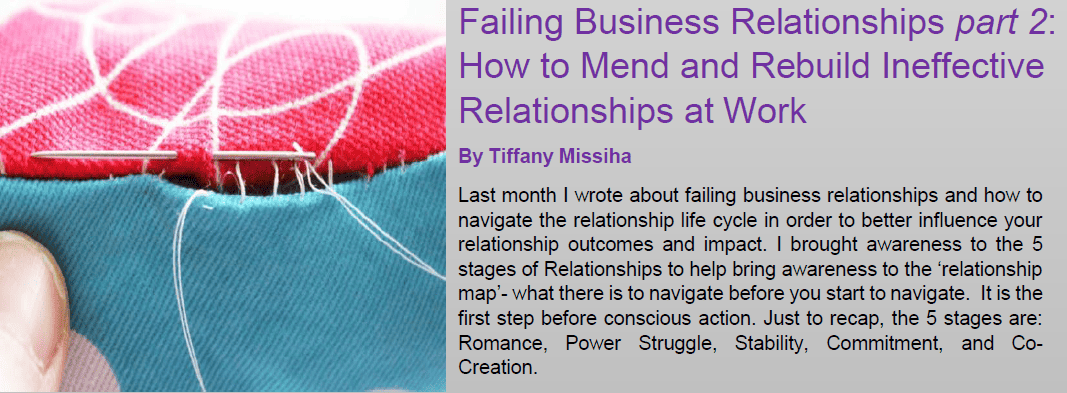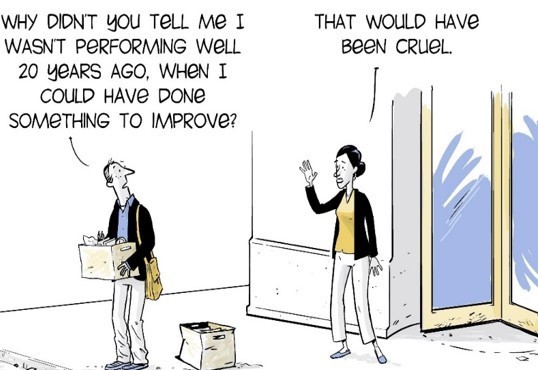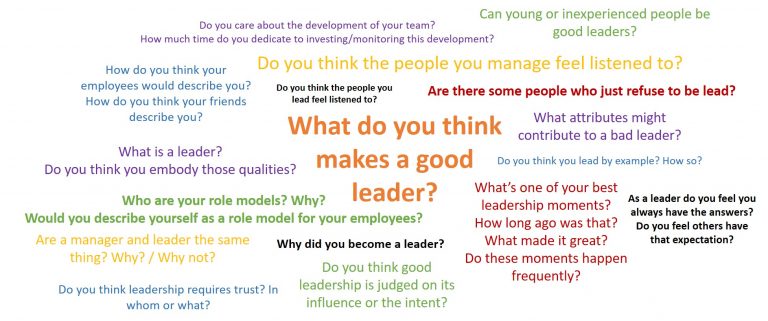Failing Business Relationships part 2: How to Mend and Rebuild Ineffective Relationships at Work
 There is a dangerous assumption that plagues businesses and teams about relationships, which goes something like this: if we are not actively in conflict or disagreement, then everything is fine- just get on with it. Another common one is something along the lines of: if there is no sharp pain, then we’re good to go. This is quite a black and white approach to assessing the strength and quality of your relationships, but the problem is like most things involving humans, there can be a lot of grey. Navigating the grey can be tricky. There doesn’t have to be a strong, burning pain in order to indicate a troubled business relationship. Funny enough, sometimes no feeling at all- what I like to call, apathy or emotional deadness- can be just as dangerous. The important thing is that it’s not just about tension & conflict- active indicators of relationship issues. Contempt, avoidance, withdrawal, neglect, and apathy are all just as, if not potentially more, dangerous because they can be blind to the eye and they impact in ways that we can’t even see; we only see the impact months or years later. Like many things, you can get by, and quite frankly most people do. The path of least resistance is often more appealing, after all. You can get by, but you will not achieve your highest level of business success with key relationships that are ‘just getting by’. You will not influence at your best. If you’re willing to explore options on how to deal with ineffective relationships, read on.
There is a dangerous assumption that plagues businesses and teams about relationships, which goes something like this: if we are not actively in conflict or disagreement, then everything is fine- just get on with it. Another common one is something along the lines of: if there is no sharp pain, then we’re good to go. This is quite a black and white approach to assessing the strength and quality of your relationships, but the problem is like most things involving humans, there can be a lot of grey. Navigating the grey can be tricky. There doesn’t have to be a strong, burning pain in order to indicate a troubled business relationship. Funny enough, sometimes no feeling at all- what I like to call, apathy or emotional deadness- can be just as dangerous. The important thing is that it’s not just about tension & conflict- active indicators of relationship issues. Contempt, avoidance, withdrawal, neglect, and apathy are all just as, if not potentially more, dangerous because they can be blind to the eye and they impact in ways that we can’t even see; we only see the impact months or years later. Like many things, you can get by, and quite frankly most people do. The path of least resistance is often more appealing, after all. You can get by, but you will not achieve your highest level of business success with key relationships that are ‘just getting by’. You will not influence at your best. If you’re willing to explore options on how to deal with ineffective relationships, read on.
Step 1: Take a litmus test of the relationship dynamic. Let’s be real here. I am not advocating that all relationships are worth the extra TLC. The reality is that they are not. Building and maintaining effective relationships takes time, work, energy, and effort. So you’re better off doing an objective, honest assessment first before deciding what to do about them; one as quickly and simply as asking yourself the following 3 questions: How important is this relationship to a) me personally and b) to the wider business success? Is this relationship mostly energising or draining me? What might the impact be over time in not doing anything here? Assuming that you’ve accepted the fact that a key relationship is not as effective as it could be, but recognise the value there is in rebuilding it to make it work, below are some ways that you could start to strengthen ineffective relationships. Proceed to…
Step 2: Keep your defences in check. If you can’t manage (not master) this then it will be futile to proceed. When we start to accept that we have part ownership of a failing business relationship, a fury of unhelpful, disempowering, and harmful creatures show up: defensiveness (I’m not the one with the problem!), blame (it’s his fault that we don’t communicate well because he’s such an introvert!), and de-valuing (well, it’s not that big of a deal anyway and I can do my job without her…). At this stage, the first most important yet undervalued thing you could do is something as elusive, invisible, and intangible as this: Create space. Yes, space. Not only physical space, but mental space between the stimulus and your triggered reaction- the one that comes almost immediately, without thought, often emotive, and often instinctive. It is often the reaction stemmed from a place of wanting to Look Good or Be Right. By starting to keep your defences in check you are more likely to succeed at your relationship-building work.
Step 3: Solicit and listen to feedback to gain objectivity and perspective. A lot of the time we are blind to the real impact that ineffective relationships have on not only ourselves but also the people around us. We can forget how loud the noise of silence, avoidance, and distraction can be to followership or other team members, and how an unhealthy relationship dynamic affects other members of the system. If you are serious about this work then gaining an outside perspective of impact- whether it’s from other members of the team, a line manager, or direct reports- is like getting a reality check of what it really feels like outside of the 2-way relationship bubble. By putting on a new set of shoes, it allows you to empathise with what it ‘feels like for them’ when there’s an unhealthy dynamic present. You also get access to objective data (observed behaviours, unhelpful communication tendencies, and so on) that can only be seen from an outsider.
Step 4: Be proactive rather than reactive. Take regular temperature checks of the relationship and invite a conversation. Keep in mind things like timing, framing of the conversation, being clear about your intentions, and owning your perspectives throughout the discussion. Quite literally, set up coffees in the diary on a regular basis to ask how are you? Rather than what’s the update on that project? Time and space needs to be protected to work ‘on’ the relationship, in the same way that work must be done ‘on’ a business. What that work looks like depends on what shape the relationship is at. It might need some serious rebuilding or it might just need some fuel and nourishment (maintenance work). In the spirit of setting expectations, here is one for you: Do not expect tensions to be dissolved overnight with these conversations. This mechanism or structure simply offers a consistent and protected space to have conversations- how you use this is key and is highly dependent on what the main issues are and what the ideal relationship outcomes are for each person.
Step 5: Set and manage expectations, and re-contract when necessary. Is it time to edit or rewrite the rules of your relationship? One of the key indicators of successful relationships is that there are clear expectations and the expectations are continually managed. Expectations can be about giving and receiving support, preferred communication and signposting habits, clarity on when and what to collaborate on and what to do solo, what information is shared, how issues are raised, and so on. Effectively managing expectations is paramount to ensuring both parties are on the same page and know what to expect, how, and by when.
Step 6: Know what good looks like. How will you know when you and Bob are in a good relationship space, knowing that relationships have lifecycles and change shapes and forms? If you at least have support, healthy challenge, trust, and assumed positive intent, then you are hovering in the right space.
We see it time and time again: business performance potential lost through ineffective relationships at work.
It is not the simplest of things to address but it does yield significant outcomes when you get it right, and you’d be surprised how so many other things fall into place as a result. We are calling on ambitious, courageous leaders to be fire-starters in challenging their fellow peers and teams to step into the discomfort of grey- relationship dynamics and systems work- to stop the value leakage so that you can drive forward in achieving your highest business ambitions.
An article by Tiffany Missiha







